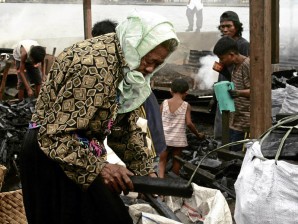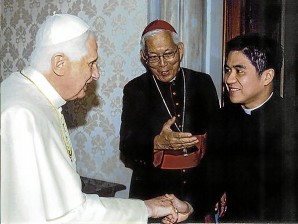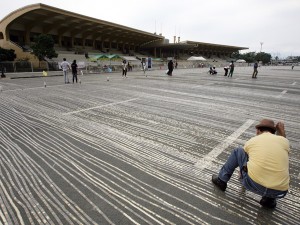Philippine Daily Inquirer
10:02 pm | Saturday, December 10th, 2011
Here’s the paradox of growth in this country.
From 2003 to 2009, the economy grew by an average of 4.8 percent. And
yet, instead of decreasing with economic growth, the number of poor Filipinos actually burgeoned from 19.8 million to 23.1 million.
So where did all that growth go? Celia Reyes of the Philippine Institute of Development Studies (PIDS) reports that a significant increase went to corporations (P3 trillion), while households only took in P2.4 trillion. In short, economic growth did not benefit the poor as much as it benefited corporations and better-off families. Economic growth, in fact, heightened the disparity between rich and poor, and across regions.
Another PIDS study covering 2004 to 2008 reveals that, despite improvements in income, two-thirds of the poor consistently earned less than the threshold income. This phenomenon, known as chronic poverty, tells us that many of the poor are born and die in poverty, leaving their children in the same abject conditions.
The National Statistical Coordination Board (NSCB) defines the “poor” as having a monthly income below P7,017 for a family of five (2009)—the minimum amount necessary to meet basic needs, including those for food, housing, education and health. Within this bracket is another group called the “subsistence poor” with monthly family incomes below P4,869: barely enough to meet basic food needs.
Statistics on poor households tend to vary. In 2009, the NSCB put poverty incidence among Filipino individuals at 26.5 percent. Using “self-rated poverty,” Social Weather Stations (SWS) found that, over the past decade, 46 percent to 66 percent of the population considered themselves poor. What remains indisputable: Poor Filipinos are growing in number, their situation growing progressively more severe.
Regions
Of the 20 poorest provinces in the country, half are in Mindanao, most of which are in Caraga and ARMM.
In terms of severity of poverty, Central Visayas and Bicol top the list: Central Visayas (181,649 families), Bicol (137,527 families) and Western Visayas (115,298 families).
The regions with the highest income inequality are Central Visayas, Eastern Visayas and Northern Mindanao. The incidence of armed conflict in these regions is particularly high.
An enduring pattern in this landscape is an old, persistent story: The farther away from the National Capital Region, the graver the poverty and inequality.
Stuck
A number of reasons explain the cycle of poverty that continues to define this reality for one in every five Filipinos:
Weak economic growth and unemployment. The poor are often solely dependent on their own labor. With poor education and health comes an inability to compete for better work. Most of the poor are also in the agricultural sector, where large populations and poor productivity continue to keep incomes low.
The poor have nearly three times the family size of better-off families. Larger family size, by increasing the number of dependents, lowers per capita incomes. Had the Philippines, with a similar population size in the 1960s, followed Thailand’s population policies over the past three decades, more than 3.6 million Filipinos (one-third of the poor) would now be out of poverty (Balisacan and Mapa, 2004).
High levels of inequality
The country has a poor record of implementing asset redistribution to the poor. Land reform has been slow and, as of 2008, less than 25 percent of ancestral domain lands had been distributed to indigenous people, over a decade after the passage of the Indigenous People’s Rights Act.
Armed conflict deters economic growth. Most severely hit by a decades-long insurgency are the provinces of Mindanao, where hundreds of thousands of Filipinos have been forced to leave their communities with little assurance of ever recovering what they’ve lost. Government resources are diverted to assist internally displaced populations, while investors continue to balk at investing in conflict-ridden areas.
Natural disasters also hurt the vulnerable most. Natural disasters greatly affect up to 6 million Filipinos every year, destroying crops, killing livestock and affecting food prices – wiping out small livelihoods and the poor’s meager belongings.
Lack of representation. Despite their large numbers, the poor are inadequately represented in local and national government, with little voice in matters that affect them most.
Who are the poor?
(See table below.)
The poor are predominantly in rural (74.8 percent) rather than urban (25.2 percent) areas (Balisacan, 2006).
Over 35 percent of Metro Manila’s population lives in informal settlements, suffer from “insecure land tenure, lack adequate health and educational facilities, and (are) unable to access capital, credit or social safety nets. They are further exposed to makeshift housing, unsafe water, poor sanitation, crime, fire and sudden flooding” (ADB, 2009).
(Lila Ramos Shahani is an assistant secretary of the National Anti-Poverty Commission.)
The poor by sector
Group Poverty Incidence (in percent) Number
Fisherfolk 49.9 482,477
Farmers/forest workers 44.0 2,095,646
Women 30.1 12,806,177
Children 40.8 14,405,899
Urban poor 16.1 6,852,965
http://bit.ly/ukVmCf
So where did all that growth go? Celia Reyes of the Philippine Institute of Development Studies (PIDS) reports that a significant increase went to corporations (P3 trillion), while households only took in P2.4 trillion. In short, economic growth did not benefit the poor as much as it benefited corporations and better-off families. Economic growth, in fact, heightened the disparity between rich and poor, and across regions.
Another PIDS study covering 2004 to 2008 reveals that, despite improvements in income, two-thirds of the poor consistently earned less than the threshold income. This phenomenon, known as chronic poverty, tells us that many of the poor are born and die in poverty, leaving their children in the same abject conditions.
The National Statistical Coordination Board (NSCB) defines the “poor” as having a monthly income below P7,017 for a family of five (2009)—the minimum amount necessary to meet basic needs, including those for food, housing, education and health. Within this bracket is another group called the “subsistence poor” with monthly family incomes below P4,869: barely enough to meet basic food needs.
Statistics on poor households tend to vary. In 2009, the NSCB put poverty incidence among Filipino individuals at 26.5 percent. Using “self-rated poverty,” Social Weather Stations (SWS) found that, over the past decade, 46 percent to 66 percent of the population considered themselves poor. What remains indisputable: Poor Filipinos are growing in number, their situation growing progressively more severe.
Regions
Of the 20 poorest provinces in the country, half are in Mindanao, most of which are in Caraga and ARMM.
In terms of severity of poverty, Central Visayas and Bicol top the list: Central Visayas (181,649 families), Bicol (137,527 families) and Western Visayas (115,298 families).
The regions with the highest income inequality are Central Visayas, Eastern Visayas and Northern Mindanao. The incidence of armed conflict in these regions is particularly high.
An enduring pattern in this landscape is an old, persistent story: The farther away from the National Capital Region, the graver the poverty and inequality.
Stuck
A number of reasons explain the cycle of poverty that continues to define this reality for one in every five Filipinos:
Weak economic growth and unemployment. The poor are often solely dependent on their own labor. With poor education and health comes an inability to compete for better work. Most of the poor are also in the agricultural sector, where large populations and poor productivity continue to keep incomes low.
The poor have nearly three times the family size of better-off families. Larger family size, by increasing the number of dependents, lowers per capita incomes. Had the Philippines, with a similar population size in the 1960s, followed Thailand’s population policies over the past three decades, more than 3.6 million Filipinos (one-third of the poor) would now be out of poverty (Balisacan and Mapa, 2004).
High levels of inequality
The country has a poor record of implementing asset redistribution to the poor. Land reform has been slow and, as of 2008, less than 25 percent of ancestral domain lands had been distributed to indigenous people, over a decade after the passage of the Indigenous People’s Rights Act.
Armed conflict deters economic growth. Most severely hit by a decades-long insurgency are the provinces of Mindanao, where hundreds of thousands of Filipinos have been forced to leave their communities with little assurance of ever recovering what they’ve lost. Government resources are diverted to assist internally displaced populations, while investors continue to balk at investing in conflict-ridden areas.
Natural disasters also hurt the vulnerable most. Natural disasters greatly affect up to 6 million Filipinos every year, destroying crops, killing livestock and affecting food prices – wiping out small livelihoods and the poor’s meager belongings.
Lack of representation. Despite their large numbers, the poor are inadequately represented in local and national government, with little voice in matters that affect them most.
Who are the poor?
(See table below.)
The poor are predominantly in rural (74.8 percent) rather than urban (25.2 percent) areas (Balisacan, 2006).
Over 35 percent of Metro Manila’s population lives in informal settlements, suffer from “insecure land tenure, lack adequate health and educational facilities, and (are) unable to access capital, credit or social safety nets. They are further exposed to makeshift housing, unsafe water, poor sanitation, crime, fire and sudden flooding” (ADB, 2009).
(Lila Ramos Shahani is an assistant secretary of the National Anti-Poverty Commission.)
The poor by sector
Group Poverty Incidence (in percent) Number
Fisherfolk 49.9 482,477
Farmers/forest workers 44.0 2,095,646
Women 30.1 12,806,177
Children 40.8 14,405,899
Urban poor 16.1 6,852,965
http://bit.ly/ukVmCf


